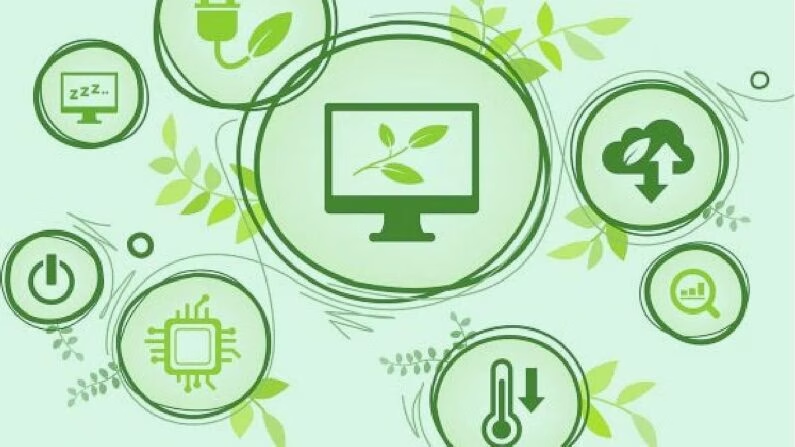- Developers
- Developer Blog
- Software Development
- Software Sustainability – How to Achieve it?

profile

By Faiza Khalid
Verified Expert
5 years of experience
Faiza is a CIS engineer with a keen interest in software development, AI research, and technology writing.
Are you interested in software sustainability and looking for ways to make your software development lifecycle more sustainable?
As digital proliferates in all aspects of human experience, so does an increase in software energy consumption. Each interaction with software requires some energy. Multiply this requirement by billions of transactions, and the carbon footprint grows significantly.
60% of greenhouse gases are produced from servers, networks, and data storage. Data centers consume 2% of global electricity today and are expected to consume as much as 8% by 2030.
In response to the growing realization and commitment towards environmental sustainability, nearly half of Fortune 500 companies have agreed to reduce emissions by 2030. Tech companies around the globe, including Apple, Dell, and Microsoft are working towards achieving net-zero emissions.
United Nations 17 Sustainable Development Goals (SDGs) and Economic, Social, and Governance (ESG) principles are prominent examples of global efforts to minimize climate catastrophe.
Individual behavior is also greatly influenced by the growing awareness of climate change and responsible living. 79% of consumers are changing their preferences based on sustainability, while 46% of workers want to join a company with sustainable practices.
Given the growing landscape for sustainable development, it is the right time for you, as business CEO or CTO, to opt for software sustainability.
Sustainable software development requires a thorough understanding of green software practices, sustainable infrastructure, and sustainability guidelines and frameworks, besides exceptional skills in software design, development, testing, and deployment.
If you don’t have a professional team with this relevant expertise to take on that task, then submit a request for a complimentary discovery call, and one of our tech account managers who managed similar projects will contact you shortly.
We now discuss how you can introduce sustainable practices in your software development lifecycle (SDLC).

Get a complimentary discovery call and a free ballpark estimate for your project
Trusted by 100x of startups and companies like
Introduce Software Sustainability in Your SDLC
An agile SDLC starts from the conception of a product idea, includes the phases of requirements gathering, software design, MVP development, testing, and delivery of software in the user market, and ends at the review of the software process and product.
Some guidelines for introducing software sustainability practices at each stage of your development processes include the following:
Software Requirements
When gathering requirements and planning software features, start with the question, do I really need it?
Software bloat is very common. According to statistics, 50% of software features are hardly ever used, and 80% have very little value for a business.
Adopt agile principles of minimizing waste and maximizing value and modern software delivery practices of lean development to build what is valuable to end users and your enterprise in the long run.
By developing minimal software, you not only reduce energy consumption but also get other benefits. You need to refactor fewer lines of code, bear fewer operational costs, maintain minimum software and hardware resources, etc.
Design and Software Sustainability
One of the crucial aspects of decision-making for green computing is the choice of architectural designs. The architecture you opt for guides the need for hardware resources. It impacts how efficiently you optimize your software, the amount of data you store on hardware, etc.
Just like minimizing software features is a valuable approach toward green software development, the use of minimal architecture designs also plays a huge role in software sustainability.
Consider the following when adopting a minimal software design approach:
- Adopt a modular approach as long as possible. Distribute only when essential to avoid complexity.
- Leverage lightweight containers for application deployment and hosting.
- Replace long-term services with serverless computing and function as a service (FaaS). They lead to less idle time and optimized energy consumption.
- Utilize public cloud infrastructure, as it is more energy-efficient than on-premise servers and data centers.
- Plan to adopt cloud-native services.
- Cloud migration and implementation of edge computing can help reduce carbon emissions via efficient data processing, reducing storage waste, data compression, workload management, etc.
- Create UI/UX designs for end-user devices with efficient accessibility and performance optimization in mind. Design easier navigation flows, support for dark mode, compress media files, etc.
Development
Writing efficient code is fundamental for software sustainability. One of the main tradeoffs in sustainable software development is simplicity vs. efficiency.
Simple code means quick to write, easier to understand, fewer functional errors, and easy maintenance. However, the code solution might not be the most efficient one.
Algorithm and data structure selection for software sustainability
Take an example of insertion sort. It checks all the above boxes of easy understandability and maintainability but has a worst-case complexity of O(n^2), meaning the time to solve the problem increases proportionally to the square of the increase in the data.
On the other hand, merge sort is hard to understand and complex to solve with splitting, recursion, and merging, but has a linear time complexity of O(n log n). The resource requirement and energy consumption are significantly lower, even with the increase in the data volume.
The choice of data structures is also critically important. For example, to search for elements in a list, use collections with hashing functions and reduce processor cycles as there would be no requirement to traverse the whole list.
Developers need enough expertise and understanding of underlying algorithms and data structures packed in a “well-tested library” to make better tradeoffs while developing sustainable software.
An important point to note is that less time does not necessarily mean less carbon emissions. For example, parallel processing generally reduces the overall processing time, but more parallelism results in the utilization of more resources running in parallel and more energy consumption and carbon emissions.
Hire expert software developers for your next project
1,200 top developers
us since 2016
Development tools and software sustainability
Also, choose your development tools and technologies carefully. For example, some programming languages are more efficient than others.
- Compiled languages are more energy-efficient than interpreted languages.
- Python holds the top position as of writing in the TIOBE language index. It is largely used in large-scale enterprise-level applications for data analytics, machine learning, etc. Interestingly, Python is among the five languages that are slowest and consume more energy.
- Three interpreted languages, TypeScript, JavaScript, and PHP, are energy-efficient in several scenarios.
- Complied languages, such as Go, C++, Pascal, etc., require less memory.
Utilize and contribute to open-source tools and libraries. Evaluate the tradeoffs between different technologies, such as scalability, security, reliability, etc. Avoid using about-to-be obsolete technologies, as they can hinder the progress and maintenance of your software.
Use of the latest technologies
Advanced technologies of artificial intelligence and machine learning can help with software sustainability. Models can be finetuned and repurposed for other tasks. This can greatly cut down on resource utilization.
Distribution ledger technology (DLT) algorithms can have positive impacts on carbon footprint as they are energy efficient. Some examples include consensus algorithm, compression strategy, increased transaction frequency, etc.
Testing and Software Sustainability
Software testing helps ensure we meet our functional and non-functional requirements. In agile development, teams extensively run automated tests.
There are test script packs at all testing levels. In case of code changes, tests run to verify these changes. The tests range from unit and integration to regression and UI tests. Each of these test runs has an energy cost.
In large enterprises with multiple software releases and data sets, the impact of software testing could be significant in terms of emissions and time.
An approach to control and account for test runs is a change-aware testing method. The approach includes tagging tests to control which of these tests would run depending on the context of code changes.
Google has developed a change-aware testing platform for its automated testing platform. Even with vast infrastructure and computation resources, Google could not cater to individual code commits and test requests. The solution is to control test execution based on code changes.
Predictive Test Selection is an advanced approach for controlled testing where machine learning helps predict which tests to run based on extensive data of test outcomes.
Test Impact Analysis is another method for efficient software testing. It is particularly useful in continuous integration and delivery (CI/CD) pipelines by ensuring that only relevant tests run in case of code changes.
The method detects code changes using a tool, performs dependency analysis to analyze which parts of code are affected, identifies which test cases are impacted by these changes, selects test routines, and executes them.
Test Impact Analysis is available with Visual Studio IDE and can be used with Azure CI/CD pipelines.
Deployment and Review
A vital goal of green software product development is to measure, learn, and improve. This approach is possible by using the right deployment tools and observation metrics.
Monitoring software sustainability
Some important metrics to monitor for software sustainability include user interaction with your application, hardware utilization, energy consumption, etc. These metrics help you with the following:
- Identify opportunities to apply green development practices. Prioritize these opportunities in the product backlog for future development iterations. Some examples include optimizing computational resources, like memory and servers, locating key emission areas and refactoring them, etc.
- Understanding how users interact with your application helps you identify valuable features for your end-users. You can remove functionality that delivers little to no value and build efficient software that offers real-world value.
- Measure the impact of your current release. It is difficult to gauge the real impact of a feature before the production stage. By analyzing the real-world impact of your software on the environment, you get a clear picture of the value-cost relationship for your application.
We suggest you utilize tools for smooth green software deployment and monitoring, for example, emissions monitoring tools.
Hire expert software developers for your next project
All leading cloud service providers provide reports on cloud emissions in operations. Such reporting is a simple way to understand, refine, and bring energy and emissions accountability to the cloud.
Automation
Numerous repeatable manual tasks are often a part of the run state in the deployment phase. Continuous improvement activities help reduce repetitive tasks and overall emissions. These could be related to process optimization, such as data transfer, user management, etc.
Cleanup for software sustainability
Large business applications are prone to the wastage of compute and storage resources. It is essential to clean your development resources and environment. These could include cleaning your business data, removing inactive users, timely removal of temporary resources, etc.
Retrospectives
Retrospective meetings in an agile environment help discuss what has worked and what has not in the completed sprint/iteration.
Include discussions on green development practices in your retrospective sessions to share views, suggest sustainability practices, and foster a collective mindset towards green development.
Planning for Sustainable Software Development?
Sustainable application development is essential for positive environmental impact by reducing carbon emissions. It also assists with cost efficiency and brand reputation in the software industry.
However, software sustainability in terms of reducing energy consumption is an emerging trend with growing standards, frameworks, and policies for software companies, including Corporate Sustainability Reporting Directives (CSRD), Streamlined Energy and Carbon Reporting (SECR), etc.
If you plan on including sustainable development in your business objectives, please note that such green IT projects require professionals with environment awareness, energy-efficient development skills, knowledge of sustainable design principles, green development architecture, CI/CD process, sustainable data management, etc.
If you do not find such software engineers on your project team, DevTeamSpace can help you via its community of field-expert software developers. All our developers are vetted, trained on cutting-edge technologies, and work full-time on client projects.
Senior developers with experience in developing similar software solutions manage these developers. Moreover, all our developers follow an AI-powered agile process for efficient project management and streamlined communication.
You can assign your complete green application development project to dev teams at DevTeam.Space or hire individual developers from us to augment your existing development team.
If you wish to know more about how we can help you introduce sustainability into your development process and the final product, send us your initial project specifications. One of our account managers will contact you shortly to discuss further details.
FAQs on Software Sustainability
Sustainability software includes applications or tools designed to help enhance and support the sustainability efforts of a business. Common types of sustainable or energy-efficient software include environmental management software, sustainable supply chain software, corporate social responsibility software (CRS), etc
Sustainable software applications help optimize hardware resources, reduce the carbon footprint, and support large-scale climate change initiatives. Software applications also help adopt sustainability practices in various industries in the form of energy management systems, environment monitoring systems, renewable energy integration systems, waste management software, etc
Sustainable software application development includes incorporating green practices in every development lifecycle stage. Some ways to achieve software sustainability and energy efficiency include optimizing algorithms, adopting efficient coding practices, using energy-efficient development tools, etc. Read this article for more details.

Alexey Semeney
Founder of DevTeam.Space
Hire Alexey and His Team To Build a Great Product
Alexey is the founder of DevTeam.Space. He is award nominee among TOP 26 mentors of FI's 'Global Startup Mentor Awards'.
Alexey is Expert Startup Review Panel member and advices the oldest angel investment group in Silicon Valley on products investment deals.


